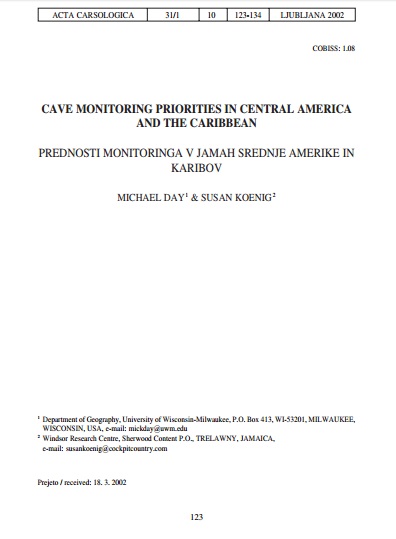Cave Monitoring Priorities in Central America and the Caribbean
DOI:
https://doi.org/10.3986/ac.v31i1.408Povzetek
Kras pokriva okrog 300.000 km2 (50 %) ozemlja Srednje Amerike in Karibov. Jam je verjetno več desettisoč. V celotni Srednji Ameriki in Karibih je monitoring v jamah zelo redek in agencije za urejanje in varstvo okolja ga nizko cenijo. Izjeme se pojavljajo le v nekaterih zaščitenih področjih in v redkih turističnih jamah. Z mnenjem, da je monitoring res potreben, se v splošnem ne strinjajo. Poleg tega je monitoring omejen zaradi nezadostnega financiranja in opreme in zaradi pomanjkanja ustrezno usposobljenega osebja. Vendar je monitoring v jamah nedvomno potreben, kajti jamsko okolje je izrazito občutljivo in kraška pokrajina doživlja naraščajoč pritisk zaradi razvoja. V tej zvezi je nujna inventarizacija in program monitoringa vsaj v bolj pomembnih jamah. Tak monitoring se lahko usmeri na fizično okolje, zgodovinske ali predzgodovinske ostanke, favno, izkoriščanje surovin, kakovost vode in turistični obisk. Enako pomembno je izvajanje monitoringa na kraškem površju, kajti degradacija površja se nujno odraža tudi v slabšanju podzemeljskega okolja
Karstlands cover about 300,000 km2 (50%) of the land area of Central America and the Caribbean. The number of caves is probably tens of thousands. Cave monitoring is uncommon throughout Central America and the Caribbean, and is generally accorded a low priority by agencies responsible for environmental managementand conservation. Exceptions occur only in some protected areas and in a few commercial caves. Fundamentally, it is not recognized generally that there is a need to monitor caves. Beyond that, monitoring is limited severely by paucity of funding, equipment and qualified personnel. Cave monitoring clearly is warranted, however, because cave environments are inherently fragile and because the karstlands are under increasing developmental pressures. In these contexts, selected inventorying and monitoring programs seem advisable in at least some of the more significant caves. Such monitoring programs might focus on physical environments, historic and prehistoric remains, faunal populations, resource extraction, water quality and human visitation. Equally importantly, surface karst environments need to be monitored too, because degradation at the surface will almost inevitably be mirrored by deterioration in underground conditions.
Prenosi

Prenosi
Objavljeno
Kako citirati
Številka
Rubrike
Licenca
Avtorji jamčijo, da je delo njihova avtorska stvaritev, da v njem niso kršene avtorske pravice tretjih oseb ali kake druge pravice. V primeru zahtevkov tretjih oseb se avtorji zavezujejo, da bodo varovali interese založnika ter da bodo povrnili morebitno škodo.
Podrobneje v rubriki: Prispevki




